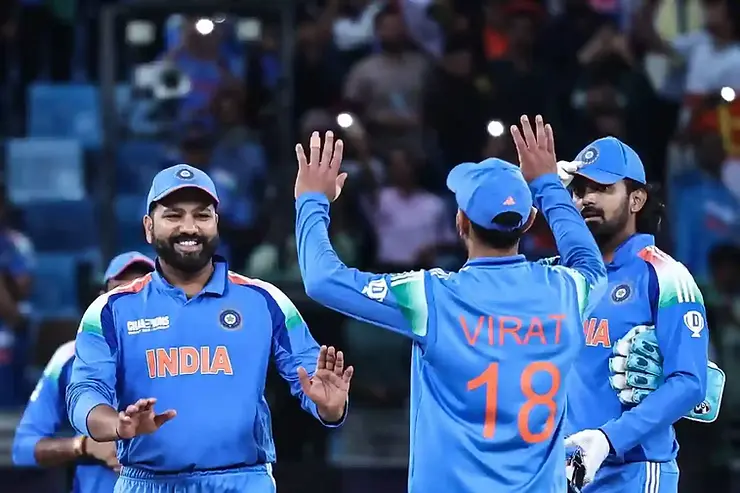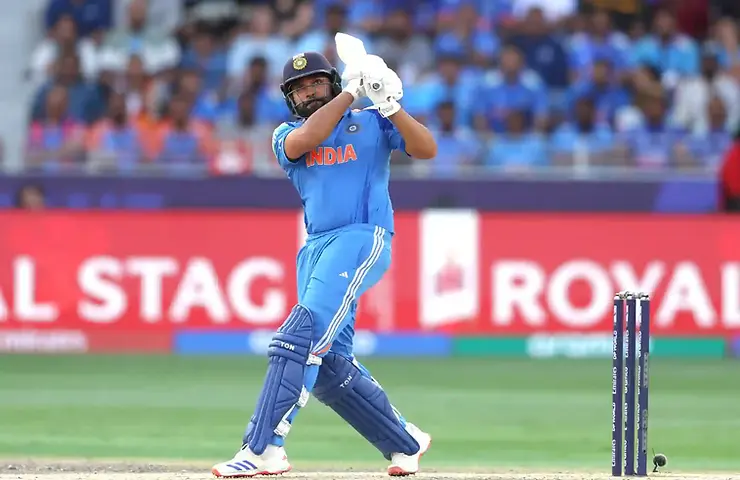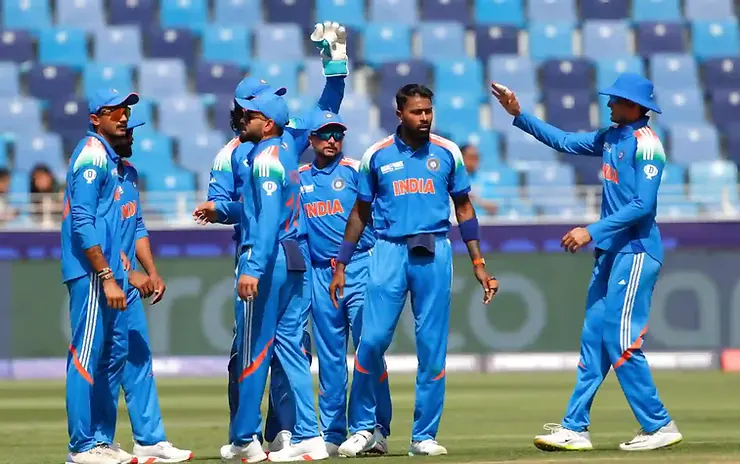What makes Team India a formidable force in white-ball cricket? Major factors behind their recent success in ICC tournaments.

Team India have been on a high since winning the 2025 Champions Trophy. They have reached the finals of the last four ICC events, winning two and finishing as runners-up twice. Their triumph in the 2024 World T20 before the Champions Trophy victory firmly established their dominance in white-ball cricket. The heartbreaking loss in the final of the 2023 ODI World Cup now feels like a distant memory.
So, what makes India such a formidable white-ball team, capable of winning two consecutive ICC titles within a year? Notably, India remained unbeaten in both these campaigns, not dropping a single match. In the last three limited-overs ICC tournaments, they have won 23 of the 24 completed games—losing only once, in the final of the 2023 ODI World Cup. Aside from that loss, India were easily the most dominant team in the tournament, with just one off day in the final.
Settled batting unit
A lot of credit goes to India’s settled batting unit in both ICC ODI tournaments. The team carried nearly the same squad in the 2025 Champions Trophy as they did in the 2023 ODI World Cup. The top five—Rohit Sharma, Shubman Gill, Virat Kohli, Shreyas Iyer, and KL Rahul—featured in the playing XI in both tournaments.
Whenever these five have played together in ODIs, India have won 18 out of 21 matches, losing just two. Except for Rohit (49.04), all four batters average above 50 in these games. However, Rohit’s strike rate (116.51) stands out, largely due to his aggressive approach in maximising the powerplay.
Here’s how India’s top five batters have performed when playing together in 21 ODIs. (Stats credit: Cricinfo)
| Player | ODIs | Runs | Average | Strike Rate | 50s/100s |
| Virat Kohli | 21 | 1221 | 71.82 | 97.05 | 6/6 |
| Rohit Sharma | 21 | 1030 | 49.04 | 116.51 | 7/1 |
| Shreyas Iyer | 21 | 994 | 52.31 | 101.42 | 6/2 |
| Shubman Gill | 21 | 972 | 51.15 | 98.98 | 6/3 |
| KL Rahul | 21 | 686 | 52.76 | 91.22 | 2/1 |
Read More: CT 2025, Final, IND vs NZ: India prevail in close game, win seventh ICC title

All-rounders add to batting depth
After these batters, India have all-rounders in Hardik Pandya, Axar Patel, and Ravindra Jadeja, who extended the batting lineup and added crucial depth in the Champions Trophy. This depth gives Rohit the license to attack right from ball one.
In the spin-friendly conditions of Dubai, India’s deep batting lineup helped them navigate tough middle overs when scoring became difficult with spinners operating and the field spread. The semi-final and final highlighted this advantage, as Jadeja came in as late as No. 8 to finish both games alongside Rahul.
Ironically, India’s batting riches meant that a high-impact player like Rishabh Pant sat out the entire tournament, with the team opting for the calm and composed Rahul to handle the finishing duties. This speaks volumes about India’s batting strength in white-ball cricket. Not just Pant, but other star batters like Yashasvi Jaiswal, Suryakumar Yadav, and Sanju Samson also missed out on the ODI squad, as India found themselves spoilt for choices in the limited-overs format.
Spin quartet and handy pace options
India didn’t miss their star bowler, the injured Jasprit Bumrah, who had played a stellar role in the 2024 World T20 campaign. Their old warhorse, Mohammed Shami, was bang on the money, shrugging off rustiness after a one-year injury layoff to register a five-wicket haul on his Champions Trophy debut. Meanwhile, Pandya complemented Shami brilliantly with the new ball.
The biggest positive for India in their Champions Trophy triumph was the performance of the spinners, who made the best use of Dubai’s conditions to keep India in command throughout. Kuldeep Yadav, Ravindra Jadeja, and Axar Patel were highly accurate with their line and length, consistently picking up wickets. The late inclusion of mystery spinner Varun Chakravarthy worked wonders, as he claimed a five-wicket haul on his Champions Trophy debut.
The four-pronged spin attack ultimately won the tournament for India. The fact that players like Arshdeep Singh, Washington Sundar, and Harshit Rana had to cool their heels in the dressing room speaks volumes about the immense bowling riches at India’s disposal.
Read More: KL Rahul’s Redemption: Overcoming the Demons of the 2023 World Cup Final

Rohit’s transformation: From anchor to aggressor
Before becoming captain, Rohit Sharma, as an opener, crafted his innings with a measured approach—preserving his wicket in the powerplay, accumulating runs in the middle overs, and then exploding in the death overs. This strategy allowed him to bat deep into the innings and helped him register three double centuries in ODIs.
However, since taking over as captain, and especially after the debacle in the 2022 World T20 semi-final against England, where India lost by 10 wickets, Rohit has taken it upon himself to bat aggressively at the top. His focus has been on maximising the powerplay—scoring as many runs as possible—to ease the pressure on the middle-order, allowing them to finish strongly or chase down targets with ease.
The stats below highlight Rohit’s approach in the first 10 overs before and after taking over as captain. (Stats credit: Cricinfo)
| First 10 overs in ODIs | Average | Strike Rate |
| Before Captain | 36.94 | 69.87 |
| After Captain | 61.52 | 119.62 |
This selfless approach saw Rohit play quick cameos in the powerplay, unsettling the bowling attack, even though it meant his big scores or centuries became less frequent. However, this aggressive intent allowed the middle-order batters to play their natural game and finish the innings strongly.
A look at Rohit’s stats highlights how his attacking approach in the first 10 overs has set him apart from other openers. Here’s how Rohit and other batters have fared in the first 10 overs in ODIs since February 2022. (Stats credit: Cricinfo)
| Average | Strike Rate | |
| Rohit Sharma | 61.52 | 119.62 |
| Others | 47.28 | 80.93 |
None more was evident than in the 2025 Champions Trophy final when Rohit went on a rampage in the powerplay, scoring 49 off 40 balls in the first 10 overs alone. He combined with Gill to put up a 108-run stand for the first wicket in just 18 overs. This quick start helped India navigate the challenging middle overs, where boundaries were hard to come by and strike rotation became difficult.
However, India could afford the luxury of a few quiet overs, as Rohit’s blistering knock ensured they remained in sync with the required run rate. This selfless approach from the skipper has been instrumental in helping India bat and bowl aggressively, leading them to two consecutive ICC titles. Credit must be given to Rohit for reshaping India’s approach to winning major tournaments.
Read More: Rohit, Virat redeem themselves in ODI format with CT 25 win

India ahead of other teams in limited-overs cricket
Compared to other teams, India are far ahead in limited-overs cricket. They play limited-overs matches, especially T20s, throughout the year. The Indian Premier League (IPL) has unearthed exciting talents like Abhishek Sharma, Tilak Varma, and Rinku Singh, who have now become stars for India in T20Is following the international retirements of Rohit Sharma, Virat Kohli, and Ravindra Jadeja from this format. While India rely on experience to win ODI tournaments, they are investing heavily in youth for T20Is—with great success in both formats.
England in transition
In comparison, England have fallen behind after their aggressive style brought them two ICC titles. They are currently in a transition phase in limited-overs cricket and need coach Brendon McCullum to replicate the success he has achieved with England in Tests.
Australia’s ageing squad, Pakistan’s unsettled combination
Australia remain overly dependent on their ageing star bowlers—Pat Cummins, Mitchell Starc, and Josh Hazlewood—whose absence was felt in the Champions Trophy. The Aussies need to groom players separately for all formats if they want to sustain success in limited-overs cricket.
Pakistan, despite their immense talent, have struggled due to constant chopping and changing at all levels—squad, management, coaching staff, and selectors—hampering their progress in all formats.
South Africa, New Zealand on par with India
On current form, South Africa and New Zealand are the only teams that have struck the right balance between youth and experience in both ODIs and T20Is. They appear to be the closest challengers to India’s dominance in white-ball cricket.
Kohli’s prediction
But if one goes by Kohli’s prediction, India’s dominance may continue for years. He believes, “We’ve a squad that’s ready to take on the world for the next eight years.” With Rohit confirming he has no immediate retirement plans and Kohli standing alongside him, the two legends can continue guiding the youngsters. If they do, India may well add more ICC trophies to their cabinet—including possibly redeeming themselves by winning the 2027 ODI World Cup.
Read More: Varun Chakravarthy 2.0: A far advanced version of his 2021 self

